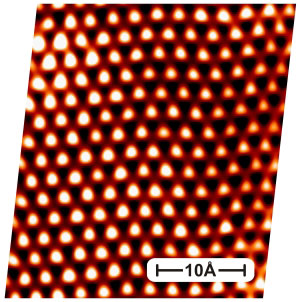| Dec 27, 2012 |
Graphene on nickel: Electrons behave like light
|
|
(Nanowerk News) Dr. Andrei Varykhalov and his colleagues in the group of Prof. Dr. Oliver Rader investigated at BESSY II the electronic properties of nickel coated with graphene and achieved an astonishing result. They could show that the conduction electrons of the graphene behave rather as light than as particles. Physicists had originally expected such behavior only for freestanding graphene layers which show a perfect honeycomb structure and not for graphene on nickel which disturbs the perfect hexagonal symmetry.
|
|
Their results are supported by calculations of two theoretical groups using novel concepts. Their report was published in the open access journal, Phys. Rev. X ("Intact Dirac Cones at Broken Sublattice Symmetry: Photoemission Study of Graphene on Ni and Co"), the new top journal of the Physical Review.
|
 |
| In a graphene sheet on nickel, every other carbon atom is strongly bonded to the nickel atom which it sits on top of while its neighboring carbon atoms do not face nickel atoms. This atomic arrangement breaks the original lattice symmetry. (Image: STM by A. Varykhalov, HZB)
|
|
Employing photoelectron spectroscopy at BESSY II, the physicists were able to establish so-called Dirac cones of massless fermions, which prove the light-like behavior. After their experiments, they could enlist two theoretical groups for supporting their results by contributing new explanations to today's publication.
|
|
“These results are surprising” says Varykhalov, the reason being that the nickel atoms interact in two different and mutually compensating ways with the carbon atoms of the graphene. On the one hand, they destroy the perfect hexagonal symmetry of the graphene lattice. On the other hand they provide the graphene layer with extra electrons - which compensates for the “damage” inflicted upon the graphene by disturbing the lattice.
|
|
“We uncovered a fundamental mechanism that is interesting for possible applications” says Varykhalov adding that graphene is usually supported by such a substrate and that the extra electrons for “healing” could as well be supplied by an electrical voltage.
|

